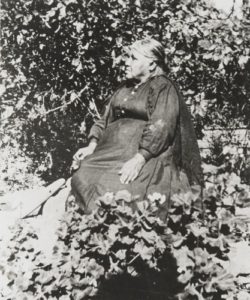
by Richard Senate
Will the removal of Fr. Junipero Serra from the pedestal in front of City Hall the debate is now who or what should replace him. It should be someone with links to our city, someone who deserves the recognition of a statue. I would like to suggest a Native American woman, a leader of her people. Her name was Candalaria Valenzula. No one knows exactly when she was born, it is estimated it was sometime around 1838 in the Sespi district of Ventura County. We know she spent much of her life in and around the village of Saticoy, just east of Ventura. She was a mission neophyte and a life-long Roman Catholic, like many of her people. She lived, in her long life to see California pass from Imperial Spain to Mexico and then become part of the United States.
Her grave was believed lost but rediscovered and is now marked, a simple plaque that proclaims her as a Chumash Native American. Candalaria is perhaps the best known of all of the Chumash People. She was a major informant to Smithsonian ethnographer John Harrington with her accounts of Chumash life and beliefs. Much of what we know about the tribe and its customs comes from her interviews.
She was born in the Sespe region of Ventura County and grew up at the Mission San Buenaventura. She was part of the household of Chumash leader Captain Luis Francisco who operated a restaurant/saloon in Saticoy. He did all he could to keep alive Native American traditions and customs. She was known for her fine baskets, and her knowledge of herbs. Candalaria was, by all accounts, a very beautiful woman in her youth.
She was married three times. She was married to Jose del Rios and this union produced a son named Teen. By the 1870s she was working as a cook at the home of the Olivas Family and here she had a long term relationship with Jose Delores Olivas that produced two children. When Jose married a “respectable” woman she left the rancho and left behind the two children who were recognized as members of the Olivas Family. They were taken in and given a good education.
After the family lost their wealth in the 1890s, Candalaria returned to help the Olivas Family. She took care of the sick and elderly mother Teodora and helped to raise Rebecca Olivas DeLa Riva’s children. Years afterward the children remembered her making dolls for them out of scraps and her huge tortillas so large they filled the whole top of the wood stove. She only moved on after the death of Teodora Olivas, and the family sold the two-story adobe home. She then married Jose Valenzuela of Sonora, Mexico.
She was working as a cook on a ranch where Lake Casitas is today. In 1917 she was badly burned when a gasoline stove she was using exploded. She died of her injuries in Ventura. She was, it is believed, 81 years old. She witnessed many changes in her long life from the days of the Missions to Ventura becoming a modern city.
She should be honored for all she did with a statue in Ventura. Before her death she told Mr. Harrington about the beliefs of her people and even recorded her voice singing the ancient songs in the Chumash Language onto wax cylinders. These crude recording still exist and are preserved and transferred to modern recording systems. Her voice is a time machine back to the days when the Chumash. She would be a perfect statue to represent Ventura.
